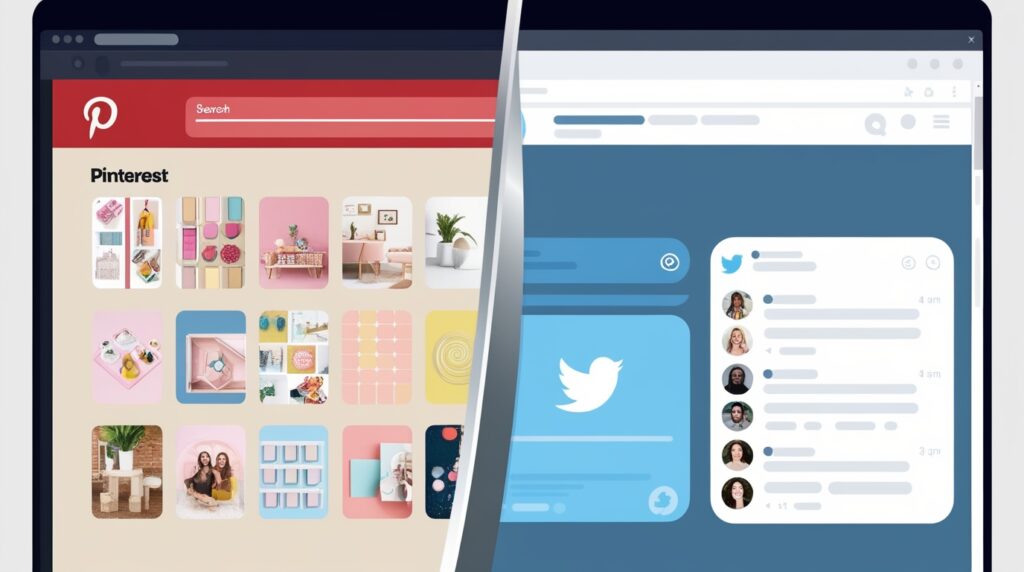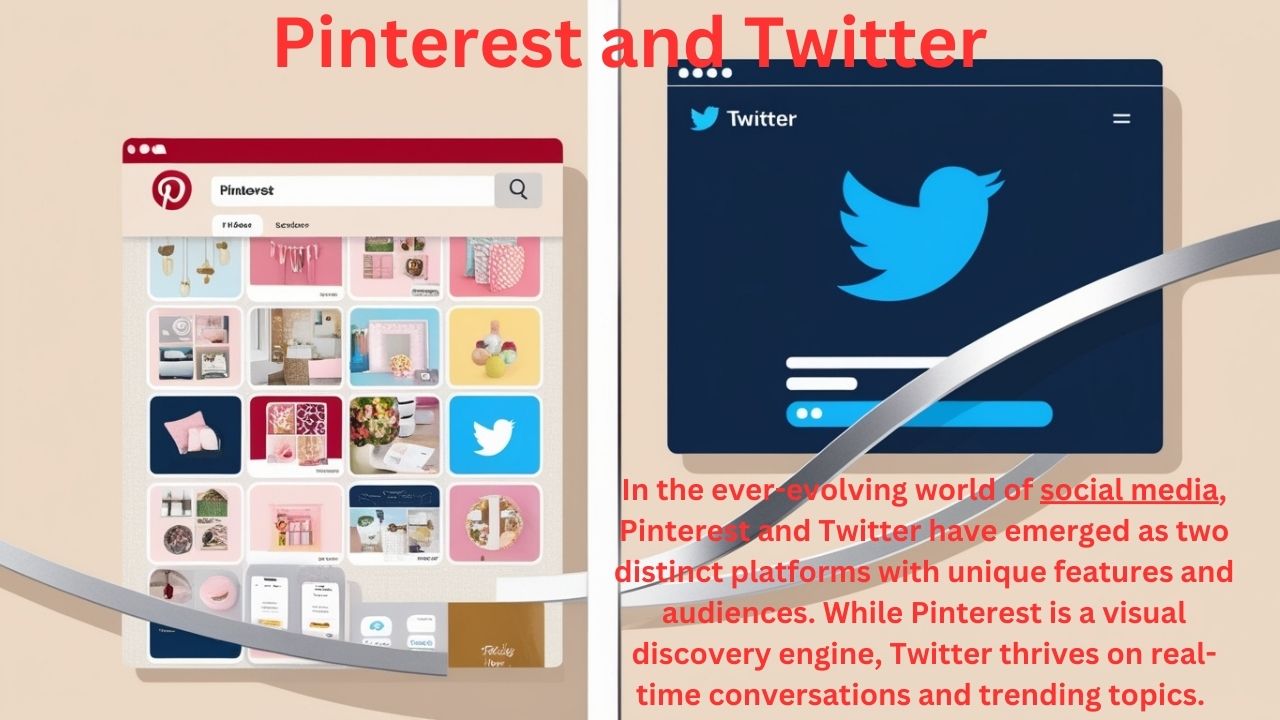Understanding Pinterest and Twitter
In the ever-evolving world of social media, Pinterest and Twitter have emerged as two distinct platforms with unique features and audiences. While Pinterest is a visual discovery engine, Twitter thrives on real-time conversations and trending topics. Both platforms offer tremendous potential for businesses, influencers, and individuals looking to build their brands, share content, and engage with their audience. This comprehensive guide will explore the relationship between Pinterest and Twitter, offering insights and strategies for leveraging both platforms to maximize your social media presence.
What is Pinterest?
Pinterest is a visual discovery and bookmarking platform where users can find, save, and share ideas, images, GIFs, and videos. With over 400 million active users, Pinterest is a powerful tool for discovering inspiration across topics, including fashion, home decor, recipes, travel, and more. Users can create boards to organize their pins and follow other users or boards that align with their interests.
What is Twitter?
Twitter is a microblogging platform that allows users to share short messages called tweets, limited to 280 characters. Known for its real-time nature, Twitter is the go-to platform for following news, trends, and public conversations. With over 330 million active users, Twitter is a hub for influencers, celebrities, businesses, and everyday users to engage with a global audience, share updates, and participate in discussions.
Pinterest and Twitter: A Synergistic Relationship
While Pinterest and Twitter serve different purposes, they can complement each other strategically. By understanding the strengths of each platform, you can create a cohesive social media strategy that amplifies your content, reaches a broader audience, and drives engagement.
1. Cross-Promotion
One of the most effective ways to leverage Pinterest and Twitter together is through cross-promotion. Here’s how you can do it:
- Share Pinterest Pins on Twitter: Whenever you pin something on Pinterest, share it on Twitter with a link back to the original pin. This not only drives traffic to your Pinterest boards but also exposes your Twitter followers to your Pinterest content.
- Embed Tweets in Pinterest Pins: Pinterest allows you to embed tweets directly into pins. This can be particularly useful if you’re running a Twitter campaign or want to highlight a tweet that resonates with your Pinterest audience.
- Promote Pinterest Boards on Twitter: Use Twitter to promote Pinterest boards by sharing links and encouraging your followers to check out your curated content.
2. Content Repurposing
Both Pinterest and Twitter are content-driven platforms, but the type of content that performs well on each can differ. By repurposing content, you can extend the lifespan of your posts and reach different audiences:
- Turn Tweets into Pinterest Graphics: Transform your most popular tweets into visually appealing graphics and pin them on Pinterest. This works well for quotes, tips, or announcements.
- Create Twitter Threads from Pinterest Content: If you have an in-depth Pinterest board on a particular topic, consider creating a Twitter thread that breaks down the key points or highlights the best pins. Link back to your Pinterest board for more detailed content.
3. Audience Engagement
Engaging with your audience is crucial for building a loyal following on any social media platform. Here’s how you can engage users on both Pinterest and Twitter:
- Run Joint Contests or Challenges: Encourage participation by running contests or challenges that span both platforms. For example, ask users to pin their favorite content on Pinterest and tweet about it using a hashtag on Twitter.
- Respond and Retweet: Stay active on Twitter by responding to mentions, retweeting relevant content, and engaging in conversations. On Pinterest, comment on pins, follow users with similar interests, and engage with your followers’ content.
- Leverage Twitter Polls and Pinterest Surveys: Use Twitter polls to gather opinions from your followers, and complement this with Pinterest surveys or questionnaires to gain deeper insights.

Leveraging Pinterest and Twitter for Business
For businesses, Pinterest and Twitter offer unique opportunities to reach and engage with potential customers. Here’s how you can make the most of both platforms:
1. Pinterest for Business
Pinterest is a powerful platform for businesses, particularly those in industries like fashion, home decor, food, and DIY. Here’s how to use Pinterest for business:
- Create a Business Account: Pinterest business account gives you access to analytics, advertising options, and other tools designed to help you grow your presence on Pinterest.
- Optimize Pins for Search: Pinterest operates like a search engine, so it’s essential to optimize your pins with relevant keywords, descriptions, and hashtags. This increases the visibility of your content and drives organic traffic.
- Use Rich Pins: Rich Pins provide additional information directly on the pin, such as pricing, product details, or ingredients. This is particularly useful for e-commerce businesses looking to drive sales through Pinterest.
- Promote Pins: Consider using Pinterest Ads to promote your pins to a broader audience. With targeting options based on demographics, interests, and behaviors, you can reach users most likely to engage with your content.
Twitter’s real-time nature makes it an ideal platform for businesses looking to engage with customers, promote products, and stay ahead of industry trends. Here’s how to use Twitter for business:
- Build a Strong Profile: Your Twitter profile is the first impression users have of your brand. Complete with a professional profile picture, bio, and links to your website or other social media accounts.
- Engage in Conversations: Twitter is all about conversation. Engage with your followers by responding to comments, participating in trending topics, and joining Twitter chats relevant to your industry.
- Use Twitter Ads: Twitter offers a variety of advertising options, including promoted tweets, accounts, and trends. Use Twitter Ads to boost your reach, drive website traffic, and increase engagement.
- Monitor and Analyze Performance: Use Twitter Analytics to track your performance, understand what content resonates with your audience, and adjust your strategy accordingly.
Integrating Pinterest and Twitter into Your Marketing Strategy
To maximize the impact of Pinterest and Twitter, it’s essential to integrate both platforms into your overall marketing strategy. Here’s how to do it:
1. Set Clear Goals
Before diving into Pinterest and Twitter, set clear goals for what you want to achieve. Whether it’s increasing brand awareness, driving website traffic, or boosting sales, having defined objectives will guide your strategy and help measure success.
2. Create a Content Calendar
Plan your content for Pinterest and Twitter by creating a content calendar. This ensures a consistent posting schedule, allows you to coordinate cross-platform promotions, and helps you stay organized.
3. Use Analytics to Inform Strategy
Both Pinterest and Twitter offer analytics tools that provide insights into your performance. Use these tools to track key metrics, identify trends, and refine your strategy based on what’s working.
4. Experiment with Different Content Types
Don’t be afraid to experiment with different types of content on Pinterest and Twitter. Try a mix of images, videos, infographics, tweets, and threads to see what resonates with your audience.
5. Engage with Influencers
Influencer marketing can be a powerful way to expand your reach on Pinterest and Twitter. Collaborate with influencers in your industry to promote your content, products, or services across both platforms.
Case Studies: Success Stories of Pinterest and Twitter Integration
Several brands have successfully integrated Pinterest and Twitter into their social media strategies. Here are a few examples:
1. Etsy
Etsy, the online marketplace for handmade and vintage items, has effectively used both Pinterest and Twitter to reach its target audience. On Pinterest, Etsy curates boards that showcase products from its sellers, driving traffic to its website. On Twitter, Etsy engages with its community by sharing tweets about new products, promotions, and trends. By cross-promoting content and engaging with users on both platforms, Etsy has built a strong online presence.
2. Whole Foods Market
Whole Foods Market, the popular grocery store chain, uses Pinterest to share recipes, meal ideas, and healthy eating tips. On Twitter, Whole Foods engages with its audience by participating in conversations about food, health, and sustainability. By integrating Pinterest and Twitter into its marketing strategy, Whole Foods has successfully positioned itself as a thought leader in the food industry.
3. Sephora
Sephora, the beauty retailer, has mastered Pinterest and Twitter to connect with its audience. On Pinterest, Sephora shares beauty tips, tutorials, and product recommendations, while on Twitter, it engages with customers through tweets about new product launches, beauty trends, and customer service inquiries. By leveraging both platforms, Sephora has created a loyal and engaged community of beauty enthusiasts.
Conclusion
Pinterest and Twitter may serve different purposes, but when used together, they can create a powerful social media strategy that drives engagement, increases brand visibility, and connects with a diverse audience. By cross-promoting content, repurposing posts, and engaging with users on both platforms, you can maximize your social media presence and achieve your marketing goals. Whether you’re a business, influencer, or individual, integrating Pinterest and Twitter into your strategy is a smart move in today’s digital landscape.
